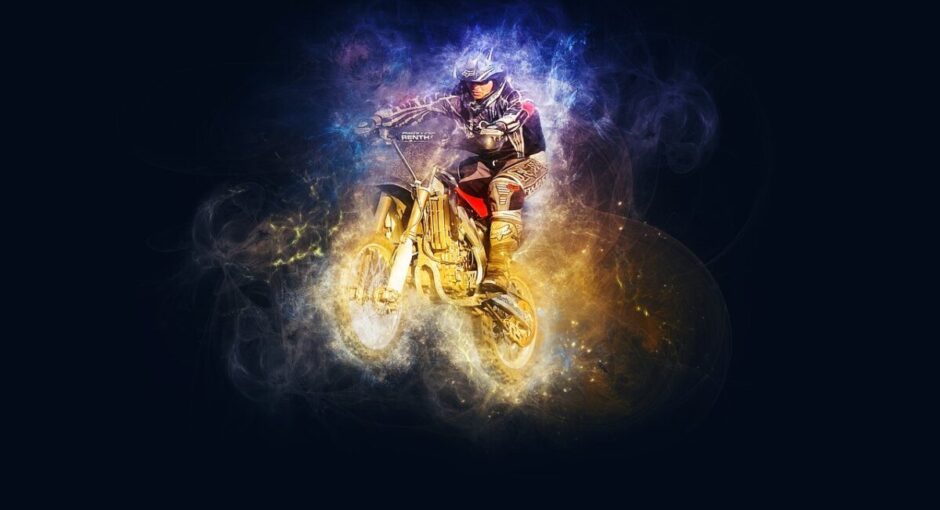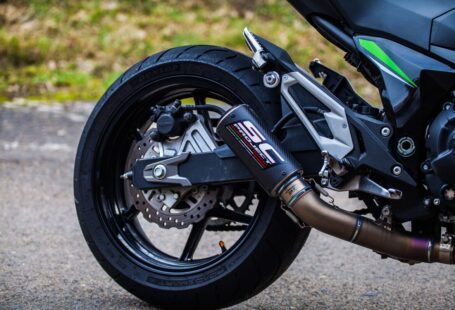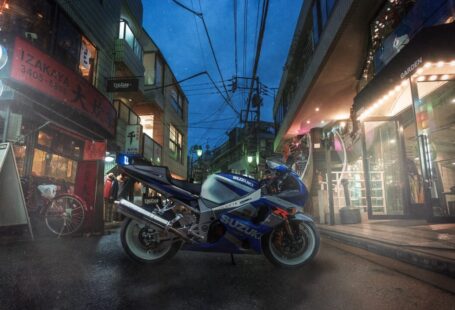The engine is derived from the latest version of Yamaha’s beautiful sounding cross-plane crankshaft engine, but it has a number of significant internal differences for improved streetability. Improved streetability means more torque at lower rpm and a bit less horsepower at higher rpm. Achieving this begins with a larger airbox. The EFI throttle bodies are modified, but only to accept the business end of electronic cruise control. The R1’s two injectors for each cylinder is now a single unit with 25-percent more flow. The second injector is omitted because its purpose is for high horsepower at high rpm for racing. As one might guess, the EFI is mapped differently from that of the R1.
The intake ports are reshaped, terminating at steel versus titanium valves. The cams have less lift and less duration, which helps flatten the dyno-graph (in a good way). The pistons are redesigned with flatter crowns and the compression is 12.0:1, while the R1 has a ratio of 13.0:1. The crankshaft has a revised moment of inertia, while the connecting rods still feature a fracture-split design. It’s fascinating that what befell Humpty Dumpty is now an intentional and preferred manufacturing process. Some things can be put back together again.
Power is delivered through a sexy slipper clutch for rpm-indiscretion forgiveness during downshifts. The transmission is unaltered yet the final drive is now two teeth taller, at 41/16 compared to the YZF-R1’s 43/16. This of course lowers the rpm for any specific speed, which is friendlier for long days of riding.
Adding to the flatter power curve is a redesigned stainless-steel exhaust system terminating with a titanium muffler. The four-into-two-into-one exhaust chamber with EXUP is reshaped and the exit pipe through the muffler has a remarkably smaller diameter, at 42.6mm compared to the R1’s 54.0mm. That’s a big difference considering, for instance, that a circle of half the diameter has only a quarter of the area. Nonetheless, the sound is soothing.
These many changes, from breathing in to exhaling out, and much, much in between, result in a claimed 18-percent more torque at a lower-revs-than-R1 peak of 9, 000 rpm.
The R1-derived aluminum deltabox frame carries an aluminum swingarm that’s also R1 derived, and KYB suspension derived from that of the R1. The package results in a slightly shorter wheelbase. The fork and rear shock are fully adjustable, and rear preload is managed with a spring-nut and spanner; please amply lubricate the shock body threads before adjusting. The shock also features high- and low-speed damping adjustability. For those new to messing up suspension, if the bike is bouncy that’s low speed, if your ass is in the air from hitting an expansion joint that’s high speed. As you might guess, the settings differ from the R1 specs, so don’t try those. Like the steel subframe, the fork triple clamps are not derived but have crossed the line to totally new. The FZ-10 weighs in at a claimed wet weight of 463 lbs., which is 24 lbs. heavier than an R1, though the FZ-10 seat height is about an inch lower, matched to lowers footpegs.
The 120/70ZR-17 front and 190/55ZR-17 rear Bridgestone Battlax Hypersport S12 W tires are specifically designed for the FZ-10. Up front is an electronic steering damper that adjusts according to the motorcycle’s speed, and each end has ABS: dual 320mm discs and radial-mounted four-piston calipers up front matched to a Brembo master—rather than the Nissin of the R1—and a single 220mm rotor and single-piston caliper out back.
The FZ-10’s distinctive robotronic headlights with heavy brows are frame-mounted for improved high-speed handling, and feature a small wind cowl that provides real wind deflection. On the backside of the wind cowl is an outlet for powering heated riding gear, charging a smartphone, and such.
The nice, big LCD display screen shows everything, and is without an analogue sister tachometer. Displayed are: Speed, rpm, Shift Light, Gear Position Fuel Gauge, TCS, Drive Mode, Air Temp, Engine Coolant Temp, Odometer, Dual Tripmeters, Fuel Reserve Tripmeter, and Instantaneous and Average Fuel Consumption. It’s a magical display in that it shows nearly all of these things simultaneously, and they are all easy to find, difficult to confuse with each other, and big enough for the semi-blind to see.
Speaking about rider aids, the three Drive-Modes are STD, A, and B. Yes, that’s an odd choice of designations, but considering all the good things about this bike it’s a joy that Yamaha did one thing weird for us to needlessly harp on. Anyway, STD is the friendliest drive mode, B is the most aggressive, and A is in between.
Traction control has four settings to choose from, and they are named 1, 2, 3, 4. 1 is least intrusive, 3 is for wet roads, and 4 is off. Please remember that 4 is not 3, and that 4 is basically -6, so don’t confuse those two. I’ve not mentioned what 2 is for because it’s a concept that’s impossible to explain. Think of it as caramel swirl when what you might desire was maple walnut.
Buttons? Did someone say “Buttons”? Amazingly, Yamaha has now likely exceeded all other manufacturers’ button counts, yet manages to do it in a clear, easy-to-use design for humans with normal-sized digits. Since doing reviews requires us to ride many bikes with many electronic options and many modes we can get confused. The success of Yamaha’s design is that the rider is not required to first scroll through a menu list, select the function desired, and then make a change to that function. On the FZ-10 the D-Modes, TC, Cruise Control, Blinkers, Highbeams, Horn, and Four-Way Flashers, all have their own buttons, and they are all in reasonable reach of that super-digit we share exclusively with primates and raccoons. It’s only the starter and kill switch that combine functions, which happens to also be a sensible design.
Unlike most manufacturers, Yamaha develops and designs its own electronic systems, resulting in differences in function and feel. But with the Yamaha Chip-Controlled Throttle (YCCT), the TC is smooth by virtue of the system overriding the rider’s throttle position choices, and it using the EFI butterflies rather than the dated means of interrupting fuel or ignition. YCCT also manages the D-Modes, altering throttle response. In each of the three modes peak power is the same and the only noticeable difference to the rider is the power delivery during throttle changes at low rpm. TC and D-mode settings can be altered on the fly, with the throttle closed. More complicated settings require the bike to be stopped.



